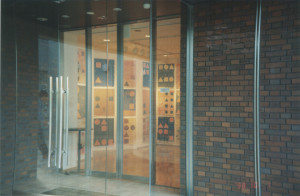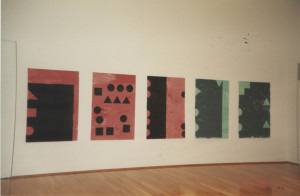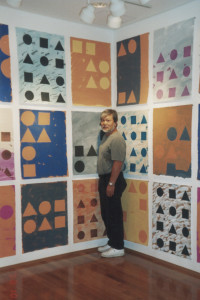Hitoshi Nakazato 50 Drawings
1998
“… This motif has become a cliche in the modernist vocabulary and been used frequently by many contemporary artists which fulfills my purpose in jest, as a parody, for expressing my disinterest in the conventions of imagemaking in art. At the same time, my intention is to focus on the means of the process, not the end, and on the perceptual and conceptual concerns and moment to moment experience of the process. …”
“… For me, it is the process itself that in the end results in some kind of imagery. This process motivates me to try again and again with inquiry and curiosity about what would happen if I were to change the system of the placement, number, size, location, allowing chance to decide the final outcome. The imagery undergoes transformation depending on the given syllogism. …”
Hitoshi Nakazato 1998, New York
Continued Meditation on the Line Outside
Although this exhibition at the Gallery Kuranuki is entitled “Fifty Drawings” a hundred drawings were actually executed as a continuation of the “Line Outside” series. The series was initially begun on the occasion of my last show at Kuranuki, then located in the same building as the Idemitsu Museum, known for its collection of Sengai works (Zen monk/ artist, 1750 – 1835). I was inspired not only to name the series “Line Outside,” a homonym for Sengai which actually means ‘monk on a cliff’ but also to choose as my motif the three primary shapes he used: circle, triangle, and square, a hundred years before the advent of modernism. This motif has become a cliche in the modernist vocabulary and been used frequently by many contemporary artists which fulfills my purpose in jest, as a parody, for expressing my disinterest in the conventions of imagemaking in art. At the same time, my intention is to focus on the means of the process, not the end, and on the perceptual and conceptual concerns and moment to moment experience of the process. The results of some of these explorations were shown in the one-person exhibition at the Tokyo Gallery in 1997 and at Drexell University in 1998.
These one hundred works can be grouped into two categories. In the first, I painted the background leaving the shapes unpainted which causes the shapes to emerge and the configuration of the image to develop. They are gray on orange, orange on gray, blue on orange, yellow on purple, and gray on yellow. The orange I began with gives the overall tone to the series. In the second category, I used brush strokes in multiple colors, a new exploration shedding the restraints I imposed upon myself previously as a should-not, depicting layers and depth, non-referentially. On top of that, the sand-texture shapes were literally dropped onto the surface. These two elements interact, at times confrontationally.
I have expressed my disinterest in focusing on the end result. For me, it is the process itself that in the end results in some kind of imagery. This process motivates me to try again and again with inquiry and curiosity about what would happen if I were to change the system of the placement, number, size, location, allowing chance to decide the final outcome. The imagery undergoes transformation depending on the given syllogism.
Totally absorbed in the making process these past few months, I felt physically engulfed in the system of inquiry which for the artist is the pinnacle of creativity, and the strong surge for further exploration. It is as I attempted to describe in my statement in a concurrent group exhibition at the Haifa Museum, “thus, the choice of motif and process…provides the vehicle for me to attain the creative terra incognia.”
Here I quote from the catalog introduction of my last show at the Gallery Kuranuki by Sandra Ericson which I feel most accurately describes some aspects of my work:
The outcome of this search, the mature version of which we see in this exhibition, is an eclecticism of means if not outcome. This is to say, while Nakazato’s paintings are not eclectic in style … they arrive at by a variety of means: they are informed by classical concerns of proportion, a Dada-like delight with chance, the Concep-tualist’s sophisticated sense of language, a Formalist fascination with the intrinsic properties of art, and last but not least an extremely developed sensitivity to the sensuous nature of color … those of Nakazato manage to remake themselves, to move forward and address the present while remembering the past and anticipa-ting the future.
Hitoshi Nakazato
August 1998, New York



